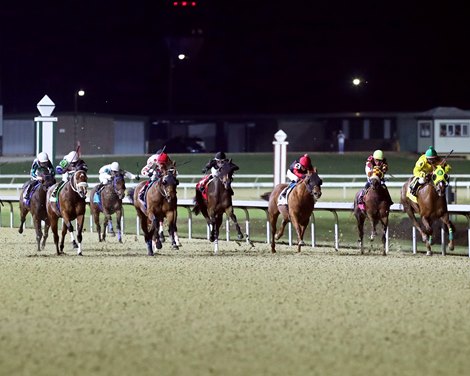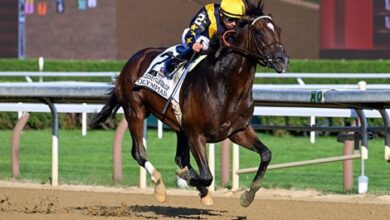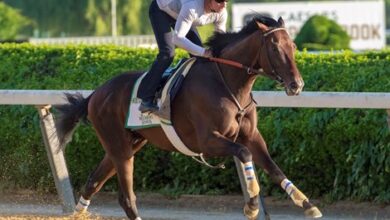BH Survey: Industry Panel Discusses Racing Calendar

To discuss several of the important issues facing the sport as a new year approaches, BloodHorse has assembled a panel of about 30 industry participants to participate in the 2023 BH Year-End Survey where they can provide their thoughts on six key topics and generate meaningful discussions on these issues.
The series continues today with a question on the racing calendar and field size. Throughout this week, panelists will provide their thoughts on racing surfaces, foal crop size, the Horseracing Integrity and Safety Authority, marketing, and wagering.
While BH realizes there are countless other voices that could have been included, the hope is that these answers will spark meaningful discussion within the industry. Anyone who would like to offer their opinion is encouraged to submit them in writing to [email protected] for inclusion in our Letters to the Editor. Longer pieces can be considered for an Our Voices column.
TODAY’S QUESTION: With smaller foal crops and horses making fewer starts, what changes, if any, would make sense for the racing calendar?
Tony Allevato, president, NYRA Bets/chief revenue officer, New York Racing Association: You have to find the right balance of being able to present a consistent product to your fan base while not diluting the product you are delivering. Striking that balance is going to be a challenge so I think you are going to see tracks in different markets aligning to create a circuit to take advantage of the talent that is out there and make sure we are not spreading horses out running in the same race on the same day at three different tracks.
Shannon Arvin, president and CEO, Keeneland: Racing calendars should be coordinated in a way that captures and holds the attention of fans. The industry needs regional markets not only to buy our horses but to develop new fans, new future trainers and vets. A potential solution is to take a serious look at how many races we run on an average race day. Most race cards are too long for fans to attend and handicap, and labor intensive for trainers and their stable crews. Baseball is a great example of a sport reimagined—reducing game times to much success this season. Royal Ascot runs seven races a day, and creates a great experience for patrons and participants. By running fewer races on certain days, and perhaps shortening the time between races, we can offer a better product for most sectors of customers. We should also consider promotion of wagering and creation of more fan-friendly wagers around events in addition to the Kentucky Derby (G1). To further enhance integrity and confidence among our customers, this conversation also should address how we can be more transparent about our pricing models. Ultimately there are only two real revenue sources: gambling dollars and new ownership dollars. The gambling dollar creates consistency and therefore sustainability, and we need to grow this through creatively engaging handicappers and the public to generate more interest in our great sport.
Dr. Dionne Benson, chief veterinary office, 1/ST Racing: Given where we are at as an industry, the rightsizing of race days is important. When there are multiple racetracks running within a few hours’ drive of one another at the same time, it stretches the horse population too thin which could impact safety. Personally, I would like to see a mandatory break for horses each year. I do not believe this requires a break from racing everywhere. Instead, I would require every horse to take an eight-week break from racing and high speed works every 52-week period. For some horses this may be in December to January, for others it would be from June to July. This would allow horses to have some downtime where they are lightly worked or turned out. Research out of Australia has shown that breaks in heavy training annually can reduce musculoskeletal injuries. As a vet, the health and safety of horses is the ultimate measure of our industry’s success and I believe we need to do whatever we can do to continue to elevate our standards, adjust our practices, and put horses first.
Louis Cella, president, Oaklawn Park: There is just too much racing. All year you can catch a race somewhere. There is no circuit, though we are trying to build one in our region. There is no start and end date to the calendar. I do believe as tracks close, this issue will work itself out to some degree.
Dennis Cornick, part owner of Flightline through West Point Thoroughbreds: With the exception of the boutique meets, there should be fewer race days across the board. Focus on the quality of racing vs. the quantity. Stats have shown that people will come, and the handle will thrive on weekends and holidays when large fields are assembled with quality horses. Make those destination weekends.
Brad Cox, trainer: As I came up as groom and hot walker, people always talked about giving horses a break in the winter. Now the racing calendar is always going. Once the Breeders’ Cup is over you turn your attention to the Kentucky Derby (G1) and Kentucky Oaks (G1). Then it’s the Preakness Stakes (G1) and Belmont Stakes (G1). Saratoga is important and then there’s the Breeders’ Cup again. It’s a long, demanding year and while it would be good to shorten it, but I’m not sure what can be done about it.
Dennis Drazin, CEO and chairman, Monmouth Park: New Jersey has reduced its calendar over the years to address the problem but nationally, or at least regionally, we need to cooperate more to avoid putting our races and stakes on the same day and planning similar race schedules. Mike Musto, executive director of the New Jersey Thoroughbred Horsemen’s Association, has advocated for a plan that offers purses of $1 million a day, every day, and to have all the tracks in our region to agree not to run on top of each other and to reduce days overall. For example, we would end up sharing all our horse colonies by permitting shipping to run and there would be high purses. But each track would agree to cut days and cooperate in a logical circuit. We should learn a little from the Covid experience. Huge days with multiple stakes and high purses in every category would benefit everyone but I doubt if everyone would cooperate on Mike’s plan. Nevertheless, it may be what we all need to save an industry from a smaller foal crop.
Drew Fleming, president and CEO, Breeders’ Cup: Rather than discussing ad hoc changes, American racing would benefit from considering a pattern committee model. For example, the European Pattern Committee has led the way on an international level by creating a balanced, high-quality annual program. Ensuring a series of races are planned over ideal distances and times of year, the committee develops a racing schedule designed to test the best horses of all ages. This comprehensive program of races, thoughtfully scheduled throughout the season, is designed to make sure the best horses cannot avoid meeting each other on every occasion. It is important for American racing to continue to explore best practices from other jurisdictions as we endeavor to address challenges and opportunities to grow our sport.
Jim Gagliano, president and COO, The Jockey Club: Tracks need to work together to stop overlapping races, and keep big races at dates/times that don’t compete with each other. Also, I’d like to see even more investment into purses for stakes races for 4-year-olds and up.
Eric Hamelback, CEO, National Horsemen’s Benevolent and Protective Association: I would start by not running innocent, good people out of the industry. We need common-sense regulations for horsemen. We must focus on equine health and welfare, along with putting horsemanship first. What doesn’t make sense is the unfunded mandate that jeopardizes smaller tracks with the crushing costs from a duplicative bureaucracy. Those who believe the collateral damage of smaller tracks closing will help the field sizes of the bigger tracks, are not seeing the entire picture. Losing markets does not help horse racing. We need a reversal of the trend rather than just accept fewer horses making fewer starts. Especially in those regions with record purse levels, we must find creative ways to incentivize ownership in the industry, making it more palatable for owners to pay training bills, which are significant. Perhaps it’s time for the industry to consider a system of sorts that gives owners and trainers a chance to run against similar competition, alongside our claiming races. I strongly believe that slashing dates and the number of races is not the answer, but we cannot just sit by and think everything will just work itself out. We should be advocating for fixing our issues, and not just being reactive to them.
Joe Harper, president and CEO, Del Mar: Racing is consolidating, but less can be more if we offer customers a stronger product to wager on. There’s a lot of talk about emulating Hong Kong and Japan. And while they both have advantages that racing in the United States doesn’t, we can learn from their quality over quantity approach.
Dottie Ingordo-Shirreffs, consultant, Thoroughbred breeding, racing, and management: I believe we need to have year-round racing to keep the fans interested and involved. Horses do need to run and compete. They have their own built-in time when a bit of R&R is needed. As for the racing calendar, it would be helpful to have the stakes schedules of various tracks reviewed and coordinated. Let there be many opportunities for handicap horses spread out. Not two or three similar races run within a short time of each other. Couple other thoughts to coordinate with all of this: We need to find a way to bring a Tex Sutton-type service back for our horses. We are all about the horse and doing the right thing, and this would truly benefit the horses and allow them to travel for stakes races and compete much more freely than what we have now. We need to work together by respecting the accomplishments and achievements of different professionals in our sport. For example, we have the trainer insurer rule. Then let’s apply it. If a trainer abuses the rules, then that trainer is the individual who is monitored and obliged to complete and submit all the paperwork. Let’s honor the integrity and professionalism of those who do it right! This is so important.
Lisa Lazarus, CEO, HISA: The structure of the racing calendar falls outside of HISA’s remit, but we are encouraged by any conversations being had in the industry that focus on driving meaningful change in the best interest of equine safety.
Dan Metzger, president, Thoroughbred Owners and Breeders Association: The simplistic answer is to run fewer races at all levels so that the number of horses in inventory can support the field size required to provide an appealing racing product. Over the last 10 years the average field size has been below eight horses a race with only small variations from year to year. The one exception was in 2020, when the average field size increased by 0.41 over 2019. The pandemic forced the industry to conduct more than 9,000 fewer races that year. When racing reopened fully in 2021, nearly 7,000 more races were run than in 2020 and the average field size decreased by 0.53. A sweeping reduction in races imposed on the industry is not the correct answer, but the industry needs to better balance the number of races with its horse inventory. Significant increases in the foal crop and starts per runner do not appear to be on the horizon, so a collaborative redevelopment by stakeholders of the racing calendar at a state and regional level is warranted.
Terry Meyocks, president and CEO, Jockeys’ Guild: With the decrease in the foal crops and the availability of horses, the industry must have open and frank discussions to determine what is working in order to ensure the racetrack is providing the best product possible. All aspects of the Thoroughbred industry must work together for the future of racing and to continue to promote our great sport. We must determine the most prudent ways to help racetracks remain viable, provide the best and safest product, and increase purses. Additionally, we have a responsibility to protect our product and be aware of the changes with casinos and sport wagering, including the impact and influence on the racing product. Racetracks might consider racing circuits in certain regions of the country to prevent overlapping dates because of the decreasing horse population and the trend toward horses making fewer starts. As a whole, the racing industry should strongly support each racetrack to have more trainers on each backside. These efforts would likely improve the product and field size, which in turn may encourage fans and handicappers to wager more and to provide a better overall experience.
Ron Moquett, trainer: I would hope that at some point we start to focus on and promote racing horses past the age of 3. So much of our sport is centered around getting to the Kentucky Derby that we lose sight of what is best for the breed and sport. Have more prestigious and lucrative races for older horses that would entice owners/trainers to not let getting to the Derby be the only thing that matters with our best runners. The Derby and all the races that lead to it are important but so was Cigar’s march to immortality. With the losses of tracks and their feature races such as the Massachusetts Handicap and Hollywood Gold Cup—along with the Pimlico Special Stakes (G3) being offered with a purse less than most state-bred stakes in Arkansas and New York—it seems to make the racing calendar after May much less interesting for older horses with fan familiarity to be involved.
Maggi Moss, owner: Long ago, it seemed like the industry was breeding a sounder horse. Horses are retiring early to become stallions, usually due to an injury. The amounts of monies being generated both at sales and with breeding is astronomical. Ironically, the middle market both at sales and at the racetracks has almost disappeared. This, along with a dwindling foal crop, and the antiquated system of races written, has created a very real shortage of horses, both for owners and at the tracks. The claiming game has radically changed, making it almost impossible to claim a horse. So, if owners or participants have a firm business plan without the desire to lose a great deal of money, and they can’t buy them or claim them, owners dwindle and this sport simply goes back to the sport of kings, with fewer owners and sadly, fewer trainers or participants in racing. Hence, the extremely small fields, and tracks struggling to fill races. Breeding horses strictly for speed, and sales where the fastest a horse works increases their value, obviously leads to fewer and fewer horses able to run, or even make it to a track. These dynamics are about money, winning the graded stakes, not about the survival of smaller tracks or the smaller owners and trainers and horses making fewer starts every year. Breeding sounder horses, stopping artificial fixes in lieu of raising a natural product is up to the breeders. More regulations or supervision over the sales to stop practices that are not ideal is happening but not soon enough.
Graham Motion, trainer: I think the situation in California is of particular concern. They don’t have access to the horse population that we have on the East Coast. On the East Coast better scheduling would help so that the same racetracks aren’t competing for the same horses.
Mike Mulvihill, president, insight and analytics, FOX Sports: Football is king in American sports and that’s not likely to change anytime soon. Every sport that can adjust its calendar to minimize football competition should seriously consider doing so. It’s challenging for horse racing to have its season-ending championships in the heart of football season. It’s also clear that two of the most iconic meets in the American game—Saratoga Race Course and Del Mar—have prime positions just prior to the start of football season. One admittedly radical idea would be to change the racing calendar to start with Labor Day weekend and end with the Breeders’ Cup in late summer. While the transitional years would be disruptive, ultimately a change in the universal birthday and in the breeding calendar would result in more mature 3-year-olds competing in the Triple Crown and a more advantageous calendar that would culminate in an August Breeders’ Cup at one of the jewel venues of the sport.
Joe Orseno, trainer, president of the Florida Thoroughbred Horsemen’s Association: Most tracks are under state mandates as to how many race dates they need to annually offer. It would be up to track management to get creative to make the most of those dates.
John Ortiz, trainer: It’s important for the racing secretaries to know the horses at their track and create the proper condition book for them. You want nine- or 10-horse fields, not five or six. You want spots where your horses can compete effectively. It’s hard to create field size when you have so many tracks in the same area who are a van ride away, but creating the races for horses on your grounds can help with that.
Mike Repole, owner, commissioner National Thoroughbred Alliance: A big help would be increasing the foal crop so we have more horses. We need to get more people involved in racing in all areas and this is where revenue sharing can help people at smaller tracks. I have 10-12 trainers working for me at all different types of tracks and by supporting these young trainers we can bring more people into the game and have better circuits.
Tom Rooney, president and CEO, National Thoroughbred Racing Association: While there is a lot of coordination of race conditions and post times happening already, there can always be improvement. Our goal as an industry should be to maximize the eyes on each race and therefore increase the betting potential. Similarly, condition books should be better coordinated so that horses in regional markets can have more race options. These minor adjustments would help not only to increase handle, but to increase viewership of the sport overall.
Tom Ryan, managing partner, SF Bloodstock and Racing: I believe the key is a blockbuster Triple Crown series. The Kentucky Derby purse must be $10 million and paid down to 10th place. Nobody skips the Derby with $10 million on the table. We need the best horses to show up every time. Preakness Stakes and Belmont Stakes need to be $5 million each. There should be three weeks between races. Add a bonus system for horses accumulating the most points across the three-race series. The spacing is equally vital to the success of the Preakness and Belmont stakes weekend schedules. Horses across the stakes calendar can’t bounce from Keeneland to the Derby to Baltimore and New York without better spacing.
John Sikura, owner and president, Hill ‘n’ Dale Farms: I don’t have an opinion on the racing schedule. For the past 25-plus years horses have trended to participate in year-round racing. I grew up in an era when horses got time off and racetracks took a break in their schedule. With the advent of simulcasting, I don’t see any change or downtime in racing.
Najja Thompson, executive director, New York Thoroughbred Breeders: The importance of year-round racing is essential. Not only for the sustainability of our sport long-term, as a viable gambling option throughout the year, but also for the livelihood of all participants. Ultimately, what any future calendar looks like will depend on the horse population in each respective jurisdiction and circuit. We must consider smaller owners and trainers who are able to make most of their income during the seasons (aside from the marquee spring through summer months) if not, that could lead to a greater decline of our foal crop than anyone could anticipate. There needs to be more collaboration and partnership between racing jurisdictions, state breeder organizations, sales companies, and gamblers on what we can do to increase the demand and keep racing competitive with attractive field size, which in turn will increase the demand. At the same time, I also think it’s important for our self-governing organizations such as the American Graded Stakes Committee to remain objective in their review of races. If the argument is made to decrease the number of graded stakes nationally, let’s ensure it is at an equitable distribution and not one region or area that is heavily impacted over others.
Elliott Walden, CEO, president, and racing manager, WinStar Farm: I think we need to work together to make a more cohesive calendar. I am not a racetrack executive, so this might be an unpopular idea, but I do not understand why Laurel Park needs to run against Parx Racing, Monmouth Park, and Delaware Park all in the summer? Isn’t there a way whereby each track makes their day a big day of the week and the focus of the eastern seaboard would be on Parx on Monday and Thursday, Laurel on Tuesday and Wednesday, Monmouth on Friday and Sunday, and Delaware on Saturday? This is an arbitrary schedule, and there might be a better solution. But I see a way where these tracks work together and jockeys would travel, horses would travel, and we reduce the number of races to increase field size.
Note: TOBA and The Jockey Club (through a subsidiary) are co-owners of BloodHorse.




